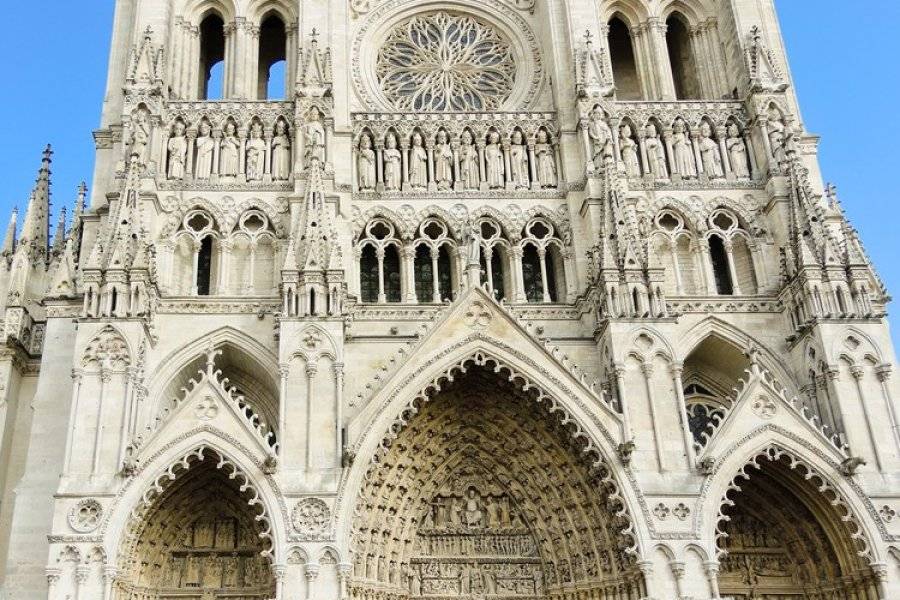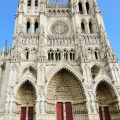A visit to the great lady, classified as a Unesco World Heritage Site, to admire the two bronze recumbents.
It's impossible to visit Amiens without admiring this grand dame, one of the jewels of French heritage. This superb, gigantic stone edifice sits enthroned in the center of Amiens. Its location and Gothic style make it emblematic of the city, and it is one of only six French cathedrals to be listed as a UNESCO World Heritage Site, where it has been since 1981. In 2020, the cathedral celebrated the 800th anniversary of the laying of its foundation stone.
It is the largest cathedral in France, and the largest Gothic building of the Middle Ages. The exceptional dimensions of this monument leave visitors speechless twice: first when they stand in front of its imposing facade, then when they step inside and face its breathtaking verticality.
But here are a few figures to give you an idea of the scale of such a building: its spire is 112 m high (note in passing that it is original and one of the oldest wooden and lead spires in Europe) and the nave vault 43 m, the total length is 145 m and the interior volume is around 200,000m3- twice that of Notre-Dame Cathedral in Paris. You could fit three average-sized churches inside! Of course, this gigantic scale posed a number of problems during construction, especially as the cathedral wasn't built in the middle of nowhere - it was understood from the outset that it would be part of the urban fabric of Amiens. To obtain the necessary space, the church of Saint-Firmin-le-Confesseur and the Hôtel-Dieu had to be demolished. The building's initiator was Evrard de Fouilloy, bishop of Amiens, who found his eternal resting place here, and whose bronze recumbent statue can be found in the nave. The town's prosperity gave the bishop the means to build a place to match his ambitions. Specializing in textile production, Amiens grew wealthy from the trade in cloth and woad (the plant from which the famous Amiens blue is made). In addition to the resources of the archbishopric, a host of private donors demonstrated great generosity.
Work began in 1220, under the direction of architect Robert de Luzarches. What makes Amiens Cathedral so special is its homogeneity. Unlike other cathedrals, where several architectural styles overlap, this one gives the impression of having been built all at once. This absolute stylistic coherence is partly explained by the fact that it took just 50 years to complete the shell. After the death of Robert de Luzarches, the work was entrusted to Thomas de Cormont, then to his son, Renaud de Cormont. Amiens Cathedral thus belongs to the classical Gothic style, in the tradition of the great French cathedrals of the 13th century. Another aspect of the cathedral that sets it apart from earlier buildings is its apparent transparency. Inside, the very high windows occupy almost the entire lateral surface. The choir, in particular, is bathed in light thanks to its triforium, which has open bays, unlike that of the nave, which is blind. Here, the masonry has been made more discreet to let the light in, and where stone used to dominate, glass has taken over. While the effect is striking for today's visitor, it's hard to imagine the impact this explosion of light could have had in the Middle Ages...
Both inside and outside the building, there are so many wonders to discover that the eye doesn't know where to stop. In the cathedral, you can admire the two 13th-century bronze recumbent statues, the labyrinth that served as an initiation course for the faithful, the 110 carved wooden stalls that served as chairs for the cathedral's canons, and the famous high relief of St. John the Baptist depicting episodes from the saint's life. But Amiens Cathedral's fame is also, and above all, due to the medieval sculptures it literally abounds in. Its western façade features three gigantic portals built between 1220 and 1230. On the lower levels of the façade, one forgets to pay attention to the multitude of details and the myriad of characters appearing in the small sculpted scenes, so much so that the eye is drawn to the imposing figures dominating the portals. The center portal, which is also the largest, features the sculpture of Le Beau Dieu, a 13th-century marvel depicting Christ blessing with his right hand. Its majestic bearing and serene attitude have earned this representation the name of Beau Dieu. Restored in the 19th century, the sculptures on the façade have been magnificently preserved.
Chroma "show : Every year, from mid-July to mid-September and at dusk in December, a superb free show is performed. Lasting 50 minutes, it comprises 20 minutes of sound and light and 30 minutes of polychromy, evoking the history of Notre-Dame and the city of Amiens through color. The façade is transformed into a gigantic screen, to the delight of locals, tourists and visiting families alike. This internationally-renowned event is not to be missed, and in itself justifies spending an extra evening in Amiens!
Did you know? This review was written by our professional authors.
Members' reviews on AMIENS CATHEDRAL
The ratings and reviews below reflect the subjective opinions of members and not the opinion of The Little Witty.





Mały minus za brak języka angielskiego w opisach. Około 30 minut na zwiedzanie.